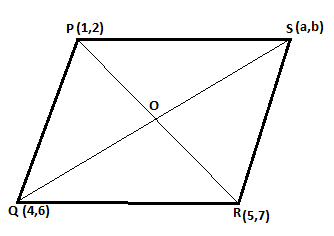
If \[P(1,2),Q(4,6),R(5,7)\] and then are vertices of parallelogram PQRS then
A.a=b , b=4
B.a=3, b=4
C.a=2, b=3
D.a=-3, b=5
Answer
573.6k+ views
Hint: Here vertices of parallelogram are given. But we need to take help of diagonals. Diagonals of parallelogram bisect each other at a point of its midpoint. So we can use the midpoint formula.
Formula used:
Midpoint formula: \[\dfrac{{{x_1} + {x_2}}}{2}\], \[\dfrac{{{y_1} + {y_2}}}{2}\]
Complete step-by-step answer:
Diagonals of parallelogram bisect each other at a point of its midpoint.
Formula used:
Midpoint formula: \[\dfrac{{{x_1} + {x_2}}}{2}\], \[\dfrac{{{y_1} + {y_2}}}{2}\]

Now since O is the midpoint of diagonals, we can use the midpoint formula of distance.
Let's take opposite vertices.
P and R as well as Q and S.
To find value of a:
\[\dfrac{{{x_1} + {x_2}}}{2}\]
\[ \Rightarrow \dfrac{{4 + a}}{2} = \dfrac{{1 + 5}}{2}\]
Cancelling 2 from both sides
\[
\Rightarrow 4 + a = 1 + 5 \\
\Rightarrow 4 + a = 6 \\
\Rightarrow a = 6 - 4 \\
\Rightarrow a = 2 \\
\]
To find value of b:
\[\dfrac{{{y_1} + {y_2}}}{2}\]
\[ \Rightarrow \dfrac{{6 + b}}{2} = \dfrac{{2 + 7}}{2}\]
Cancelling 2 from both sides
\[
\Rightarrow 6 + b = 9 \\
\Rightarrow b = 9 - 6 \\
\Rightarrow b = 3 \\
\]
Hence option C is the correct option.
Additional information:
Parallelogram is having opposite sides parallel to each other.
Note: Don’t try using distance formula or any other formula here because the diagonals of parallelogram bisect each other will lead to solve the problem.
Formula used:
Midpoint formula: \[\dfrac{{{x_1} + {x_2}}}{2}\], \[\dfrac{{{y_1} + {y_2}}}{2}\]
Complete step-by-step answer:
Diagonals of parallelogram bisect each other at a point of its midpoint.
Formula used:
Midpoint formula: \[\dfrac{{{x_1} + {x_2}}}{2}\], \[\dfrac{{{y_1} + {y_2}}}{2}\]

Now since O is the midpoint of diagonals, we can use the midpoint formula of distance.
Let's take opposite vertices.
P and R as well as Q and S.
To find value of a:
\[\dfrac{{{x_1} + {x_2}}}{2}\]
\[ \Rightarrow \dfrac{{4 + a}}{2} = \dfrac{{1 + 5}}{2}\]
Cancelling 2 from both sides
\[
\Rightarrow 4 + a = 1 + 5 \\
\Rightarrow 4 + a = 6 \\
\Rightarrow a = 6 - 4 \\
\Rightarrow a = 2 \\
\]
To find value of b:
\[\dfrac{{{y_1} + {y_2}}}{2}\]
\[ \Rightarrow \dfrac{{6 + b}}{2} = \dfrac{{2 + 7}}{2}\]
Cancelling 2 from both sides
\[
\Rightarrow 6 + b = 9 \\
\Rightarrow b = 9 - 6 \\
\Rightarrow b = 3 \\
\]
Hence option C is the correct option.
Additional information:
Parallelogram is having opposite sides parallel to each other.
Note: Don’t try using distance formula or any other formula here because the diagonals of parallelogram bisect each other will lead to solve the problem.
Recently Updated Pages
Master Class 9 Social Science: Engaging Questions & Answers for Success

Master Class 9 Science: Engaging Questions & Answers for Success

Master Class 9 English: Engaging Questions & Answers for Success

Master Class 9 Maths: Engaging Questions & Answers for Success

Master Class 9 General Knowledge: Engaging Questions & Answers for Success

Class 9 Question and Answer - Your Ultimate Solutions Guide

Trending doubts
Which places in India experience sunrise first and class 9 social science CBSE

Fill the blanks with the suitable prepositions 1 The class 9 english CBSE

Write the 6 fundamental rights of India and explain in detail

Difference Between Plant Cell and Animal Cell

What is pollution? How many types of pollution? Define it

What is the Full Form of ISI and RAW




